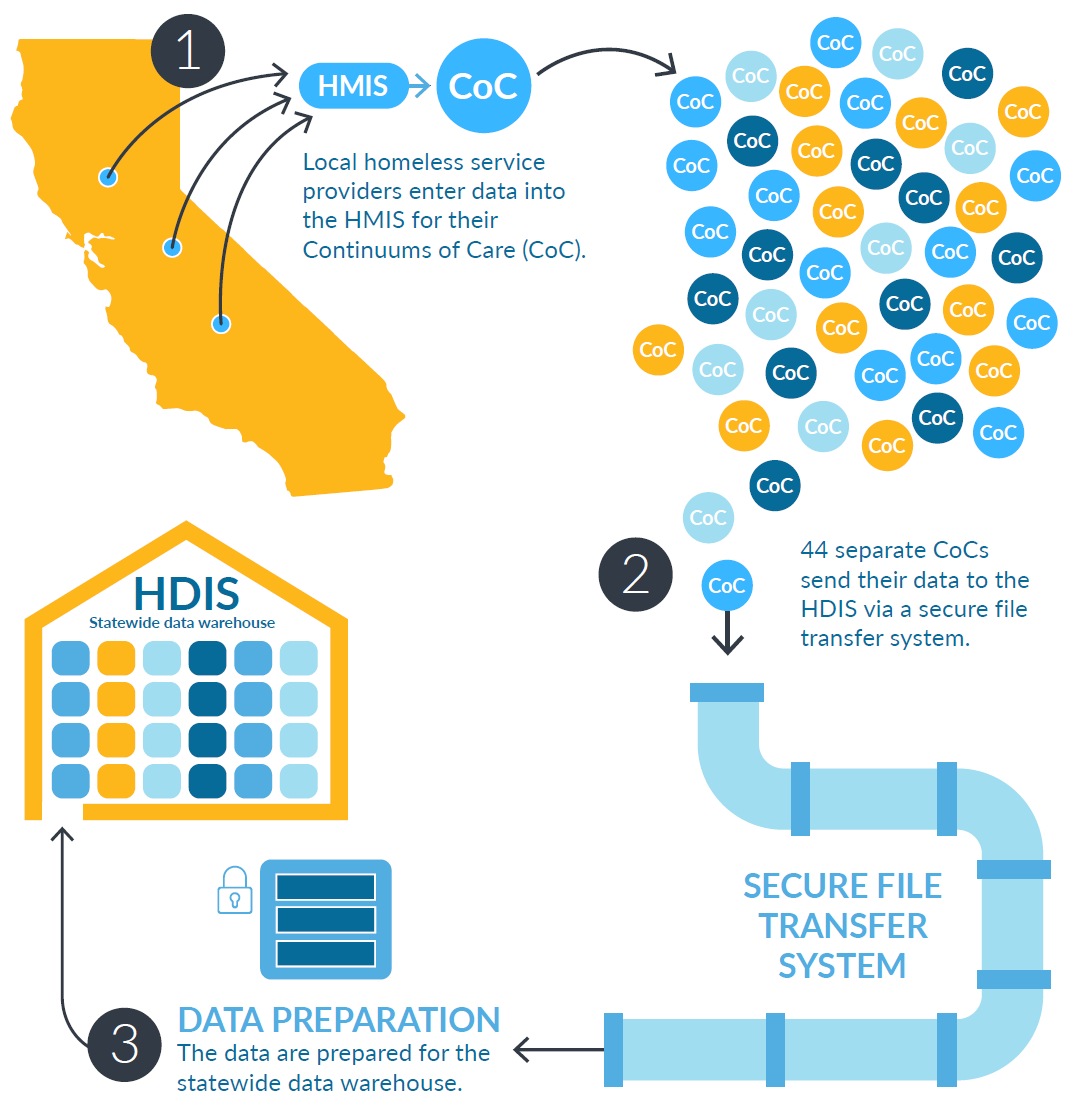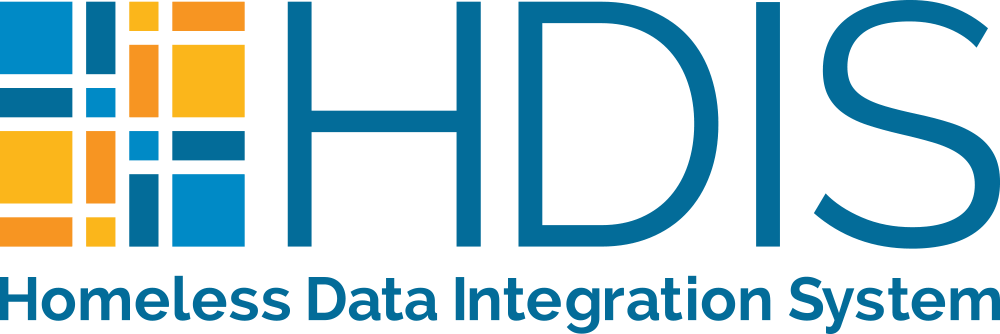Acting to Prevent, Reduce and End Homelessness
The California Interagency Council on Homelessness' Statewide Action Plan pursues a vision for the Council and state's work to prevent and end homelessness focused on purposeful, action–oriented coordination and alignment among state departments. By providing data that allows California to measure progress towards the goal of preventing and ending homelessness, the Homeless Data Integration System (HDIS) plays a pivotal role in the state's comprehensive strategy to get more Californians into affordable, stable living environments and to connect them with the supportive services they need to succeed.
HDIS compiles data submitted by Continuums of Care (CoC) which serve as the central organization within the homelessness response system. Each CoC maintains a data system, known as a Homelessness Management Information System (HMIS). Service providers that receive homelessness funding from many federal and state programs are required to enter data into HMIS.
Service providers that do not use HMIS are not included in data from HDIS. Therefore, the data does not include everyone accessing homelessness services. HDIS data does not include people accessing services and housing from the 110 federally recognized Tribes as Tribes are not required to use HMIS. Other providers that are not required to use HMIS include Victim Service Providers (organizations whose primary mission is to provide direct services to victims of domestic violence) as they are legally prohibited from entering data into HMIS.
California's Homelessness Response System Acts to Serve those in Need
In 2024, (the most recent full year of data), CoCs across California have provided housing and services to 356,660 people experiencing homelessness. Graphic A displays data for all people who accessed housing and services through local response systems. The data is disaggregated by Continuum of Care (CoC) and household structure.
Subpopulations of Californians Experiencing Homelessness who Accessed Services
Homelessness services that are tailored specifically for adults, families, youth, and other subpopulations are necessary to provide the right kinds of housing support.
In 2024, (the most recent full year of data), of those who experienced homelessness and accessed services in California:
- 234,412 people were adults living alone or in the company of other adults (referred to as adults only household).
- 121,287 were people in families with children.
Within those subpopulations, there were 47,662 unaccompanied youth (up to age 24) who experienced homelessness and accessed services in California during 2024.
We have an opportunity to act to address homelessness with an equitable approach.
Racial inequities and homelessness are inextricably linked. The number of people experiencing homelessness does not mirror the racial makeup of the state's general population. Black or African American people in California are overrepresented in homelessness--representing 7% of the state's population but 29% of those who accessed homelessness services while experiencing homelessness in 2023. The share of Black or African American people experiencing homelessness as well as the share American Indian, Alaska Native, or Indigenous people experiencing homelessness was five times greater than their respective share of the state's overall population according to the Point–in–Time (PIT) count. Note that the PIT data counts all people experiencing homelessness, while the HDIS data on this dashboard only includes people experiencing homelessness who accessed services.
California is committed to tackling racial disparities in homelessness through the implementation of Cal ICH's Action Plan for Preventing and Ending Homelessness in California. Starting in 2024, Cal ICH introduced a new approach to reporting race and ethnicity data. People in HDIS will be counted in every race and ethnicity category with which they identified whether they identify as one race or ethnicity alone or in combination with another race or ethnicity. To learn more about this approach, see Cal ICH's Race & Ethnicity Fact Sheet. Graphic B displays the overrepresentation and underrepresentation of race and ethnicity groups in the population experiencing homelessness and accessing services relative to the California general population. The data submitted by local homelessness response systems and displayed in this graphic reflects people who are served in their systems captured through HMIS only and does not capture the rates of homelessness for these populations.
Reliable data about the demographic characteristics of people being served allows state and local governments to target resources to meet the diverse needs of people experiencing homelessness and evaluate if these efforts are effective. Graphic C displays people experiencing homelessness and accessing services disaggregated by race, ethnicity, gender, age, and those who are veterans, have a disabling condition, and those who are survivors of domestic violence.
People Access Homelessness Services Locally
Data from HDIS shows that over a three–year timespan, very few people experienced homelessness in more than one California CoC. Of the people who did access services in multiple jurisdictions, most did so in adjacent or neighboring CoCs, suggesting homelessness within California is not a problem of migration. Among the records analyzed in HDIS:
Research Leveraging HDIS Data
Research using HDIS data enables policy makers, local stakeholders, and the public to better understand the state's homelessness response system. The following research briefs are part of a series looking at how homelessness services, shelter, and housing programs are meeting the needs of different populations in California, including the types of programs each population accessed and their outcomes at the end of the three–year report period.
The fact sheets provide a snapshot of how the following populations are served by programs that report in HDIS:
This series is a collaboration between the California Interagency Council on Homelessness; the Terner Center for Housing Innovation at the University of California, Berkeley; the Benioff Homelessness and Housing Initiative at the University of California, San Francisco; and Abt Associates.
The California System Performance Measures (CA SPMs) are a standardized set of metrics that use HDIS data to help the state and local jurisdictions assess progress towards preventing, reducing, and ending homelessness. The following materials explain each CA SPM and how they are calculated:
- California System Performance Measure Guide and Glossary (PDF)
- California System Performance Measure Data Points Guide (PDF)
- Comparison of California and U.S. Department of Housing and Urban Development System Performance Measures (PDF)
- Statewide and CoC CA System Performance Measures on the Open Data Portal
The HDIS is a statewide data warehouse of data from the 44 local homelessness response systems in California
HDIS compiles and processes data from all 44 California Continuums of Care (CoC)—regional homelessness service coordination and planning bodies—into a statewide data warehouse. Each CoC collects data about the people it serves through its programs, such as homelessness prevention services, street outreach services, permanent housing interventions and a range of other strategies aligned with California's Housing First objectives.

Process:
- Services are entered by local entities providing prevention, outreach, emergency sheltering, rapid rehousing, and other permanent housing, and other services.
- Cal ICH collects data on a quarterly basis by working with CoCs.
- Once ingested into HDIS, data is standardized, cleansed, de–duplicated, and matched, which makes the data much more accurate when looking at statewide figures.
For more information about how HDIS was built, for the release notes, or to submit an inquiry, check out HDIS Development and Inquiries
The Demographic Data is available for download from People Receiving Homeless Response Services by Age, Race, Ethnicity, and Gender – Datasets – California Open Data
Are you experiencing homelessness and need assistance? Check out Continuum of Care Points of Contact.
If you have questions, please contact HDIS@bcsh.ca.gov.
HDIS is administered by the California Interagency Council on Homelessness, which is housed within the Business, Consumer Services and Housing Agency (BCSH).


